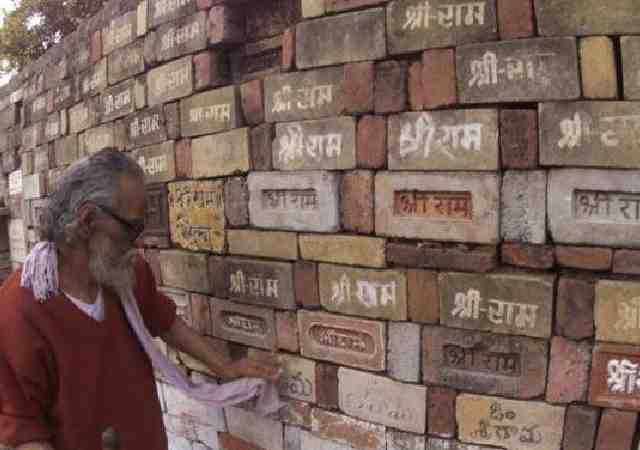BY RAKESH SINHA
Soaking up the winter sun, Haji Mehboob watched a motorcycle draw up to the verandah where he sat. “Mubarak ho, Chacha,” said the rider, sporting a red tilak on his forehead. In his 70s, the defendant in the Ayodhya lawsuit beamed: “This wouldn’t have been possible without your support. Muslims alone couldn’t have done it.”
This little exchange Friday had nothing to do with the lawsuit coming up in the Supreme Court on December 5. Haji Mehboob’s nephew Asad had just been elected on a Samajwadi Party ticket in the Uttar Pradesh local body elections and all of Terhi Bazar was turning up to greet the family.
Barely 200 metres away, BJP supporters danced in a narrow lane, celebrating the win of Hrishikesh Upadhyay who will be the first mayor of the newly constituted Ayodhya Nagar Nigam that will also administer adjoining Faizabad, the larger of the twin towns.
Twenty-five years after the destruction of the Babri Masjid at the site Hindus call the Ram Janmabhoomi, many in Ayodhya want to move on. The dispute lingers, the claims persist, and more courtroom battles lie ahead. But this little town, which Hindu outfits want turned into their Vatican, is very weary of its past and present.
The fatigue shows: its mansion-like temples are crumbling; the stench from open drains that line the lanes invade homes and shops; there’s not a single decent hotel to check in, not a hospital that people trust; and pilgrims on the road are always on the lookout — for the Vikrams that speed on three wheels, the monkey troops that come snarling, or the stray cows driven by hunger.
Ayodhya today is all that a town should not be, a decaying urban sprawl that is home to an estimated 60,000 people — the 2011 Census put its population at 55,890, up from the 40,642 in the 1991 headcount. But in December 1992, that number had swelled to almost 200,000 as the town hosted an army of kar sevaks who melted away a day after they razed the Babri Masjid and raced against time to build a makeshift temple on the mound of debris.
That single act froze Ayodhya in time and became the springboard for the BJP’s rise to power — from 120 seats in 1991 to 161 in 1996, and repeat performances of 182 in the Lok Sabha elections of 1998 and 1999.
Ayodhya today is all that a town should not be, a decaying urban sprawl that is home to an estimated 60,000 people — the 2011 Census put its population at 55,890, up from the 40,642 in the 1991 headcount. But in December 1992, that number had swelled to almost 200,000 as the town hosted an army of kar sevaks who melted away a day after they razed the Babri Masjid and raced against time to build a makeshift temple on the mound of debris.
That single act froze Ayodhya in time and became the springboard for the BJP’s rise to power — from 120 seats in 1991 to 161 in 1996, and repeat performances of 182 in the Lok Sabha elections of 1998 and 1999.
In March this year, Mahant Avaidyanath’s disciple and successor Yogi Adityanath, who was a 20-year-old in 1992, took charge of Uttar Pradesh as Chief Minister, rekindling hope in Ayodhya, among its townsmen and temple votaries.
Adityanath’s visit to the temple at the disputed site and his declaration that “Ayodhya is my personal belief, my faith”, created ripples and worried Muslims. But in May this year, his government took a major step — it announced the creation of the Ayodhya Nagar Nigam, a larger civic body formed by subsuming the Faizabad Nagar Nigam.
This was a reversal of sorts. The civic body that existed in Ayodhya had been carved out of the Faizabad Nagar Nigam in January 1978. Now, with Faizabad too under its jurisdiction, the Ayodhya Nagar Nigam has to provide civic services to the two towns. Priorities were identified. Its web site listed “ensuring proper street lighting… establishing water supply network, maintaining it and ensuring sufficient quantity of water… establishment of road network and its maintenance”. That set the stage for the grand Diwali celebrations in the town in October.
Iqbal Ansari, whose father Hashim spent a lifetime in courts as a litigant in the Ayodhya case before he died last year at the age of 95, said, “This is a holy town. Hundreds come to Ayodhya every day, but we don’t even have hotels here. People are forced to stay in Faizabad, pay for the ride to Ayodhya and back. And there’s filth everywhere. Is this how a holy place should be?”
Sudarshan, who fixes tyre punctures and runs errands for a sweetshop owner, agreed with Ansari: “It is time Ayodhya looked to the future. Look at the roads, the drains. These need to be fixed. Agar niyat sahi hai, Nagar Nigam kar sakta hai (the civic body can fix it if it wants).”
On this, there is no dispute. The Nagar Nigam is the talk of town, not the title suit hearing, not the 25th countdown to December 6.
Courtesy: The Indian Express

